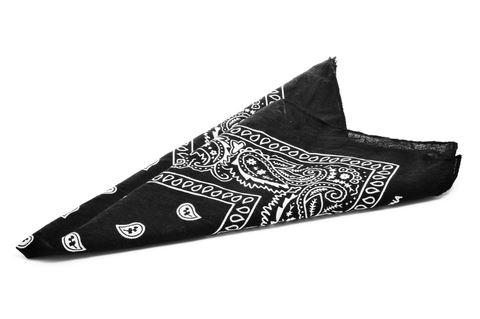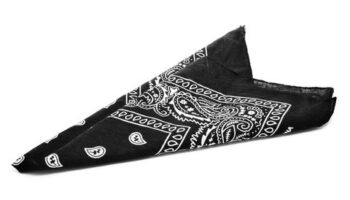You look up ahead and see a fine, sexy form. Look at those shoulders, those hips, that walk. You think to yourself, "That is sex on a sidewalk!" It's late and you’re headed out to a club. Fortunately, as you were looking up and down, you noticed something about that person just as they confidently strode into the same bar as you. Hanging out of that their left pocket was a gray hanky. Oh my. And that's when you know that the two of you will meet later.
Our world has lots of signifiers to indicate people of our "kind." Be it cultural, religious, or social, we like to be able to identify people we are similar to without even having to talk to them. Out of necessity, out of safety, and out of practicality, these visual markers can greatly help people connect in a variety of different ways.
And thus, the Hanky Code was born. Quite simply, the Hanky Code is an easy way to "flag" your sexual interests so that anyone in the know can see what you’re into. You simply dangle the handkerchief of your choice out one of your back pockets. The pocket choice is key: if you flag on the left, you "give out" the action, and if you flag on the right, you "receive" the action.
For example, that hottie above with the gray hanky in the left pocket? That person is into BDSM, and is a top. Switch that hanky to the right pocket, and they’d be a bottom.
I've seen people flagging, showing their preferences in Pride parades, at leather events, and in clubs. Not a lot, but some. It has always fascinated me - so much so that I put my DIY skills to task and created a line of Hanky Pins. They always turn heads at zone and craft fairs. Not only do people find them cute and fun ("Aren't we all running out of room in our hanky drawers?"), but many ask me about the history and use of the code. Who uses it? How did it start?
While the Hanky Code is predominantly identified with gay, male culture, its roots are actually much older and quainter. Back in the Gold Rush days, when there weren’t many women in mining towns, it is said that men would square dance together, with the fellow in the blue hanky leading the fellow in the red hanky. While some horizontal dancing on the sly surely happened as well, this simple delineation led to other means of men finding partners.
Keys were the marker of choice in the mid-twentieth century. At that time, when men were silently cruising, they would attach keys to their belt, in either the left or right position. It wasn’t until a writer for the Village Voice in New York City jokingly suggested handkerchiefs would be a better way to attract the attention you wanted that the use of hankies fell into favor. While there were only a handful of colors available back then, much more was to be made of this new man-on-man morse. Throughout the years, the Hanky Code has continued to evolve to include many different people and a slew of sexual fun. Now, you’re just as likely to see people flagging at play parties, in clubs across the queer spectrum, and at pretty much any event that draws people from sexual subcultures. Specifically, when it comes to clubbing and parties, Jeremy Feist, writer and sales pup at Northbound Leather, notes that there are definitely people flagging at parties and clubs and that there are two types of people using the code: "For the most part, there are two kinds of people who still flag: The old school, dedicated players, and the new guys who see flagging as a fashion statement."
Feist suggests the Hanky Code has moved to another level and includes other functions.
"I think there is a select group of people who see the Hanky Code as something other than a utility: It's fashion, it's a novelty, it's an accessory, whatever," Feist said.
"It used to be mandatory because being openly kinky - even being openly gay - was a liability. Everything had to be coded, otherwise you could put yourself in danger. I think Hanky Code is still used practically to a certain extent, but now that we're free to talk about what we're looking for openly, it's not something we have to use, so much as it's a tool we choose to use."
As more people have adopted flagging as a means to meet, more activities have been included. Because there weren’t many hanky colors available in the beginning, the code started out with limited colors. Now you can find a multitude of colors and preference represented - and not just using hankies either! Seriously, think of a fetish or play type and there is a code for that. Fisting? Watersports? Uniforms? Spit? There’s a code for you! Check out these diverse lists here and here. At this point, the Hanky Code is both useful, kitschy, and legendary. Indeed, it is still a valuable tool to ensure your safety when cruising. It is a great way to meet like-minded kinky folks, too. At the same time, queer and popular culture are poking little jabs at this iconic code. Justin Sayre reimagines the Hanky Code and Peaches devotes a song to it! Funny or Die has even offered a hilarious take on describing its intricacies. As our meeting mechanisms have become more digitized and less in-person, Feist notes that profile can replace the cacophony of colors and objects of the code. However, serious players still reference it. It is a funny conundrum: more and more colors and objects are being recognized to denote fetishes and activities, but it seems the code is possibly in decline. Maybe it is this continual invention of new codes that will lead to a resurgence?
If that does happen, Feist has some words of advice: "You might need to invest in a Pantone Color Guide."
Jon Pressick is a sex-related media gadabout. For more than 20 years, Jon has been putting sex into our daily conversations at his long-running site SexInWords—as a writer, editor, publisher, sex toy reviewer, radio host, workshop facilitator, event producer and more. These days, he focuses on writing for Kinkly, GetMeGiddy, The Buzz and PinkPlayMags and editing Jason Armstrong's series of Solosexual books. In 2015, Jon edited Cleis Press' Best Sex Writing of the Year, V1 to rave reviews. He's also the winner of the 2010 TNT Favourite Adult Journalist Award and one of Broken Pencil's 50 People and Places We Love past co-host and producer of Sex City. Jon co-produced the queer literary festival Writing Outside the Margins with Xtra Magazine for two years. You can find him on Twitter at @Sexinwords.




